recommended oil CHEVROLET CORVETTE 1964 Owners Manual
[x] Cancel search | Manufacturer: CHEVROLET, Model Year: 1964, Model line: CORVETTE, Model: CHEVROLET CORVETTE 1964Pages: 52, PDF Size: 11.2 MB
Page 5 of 52
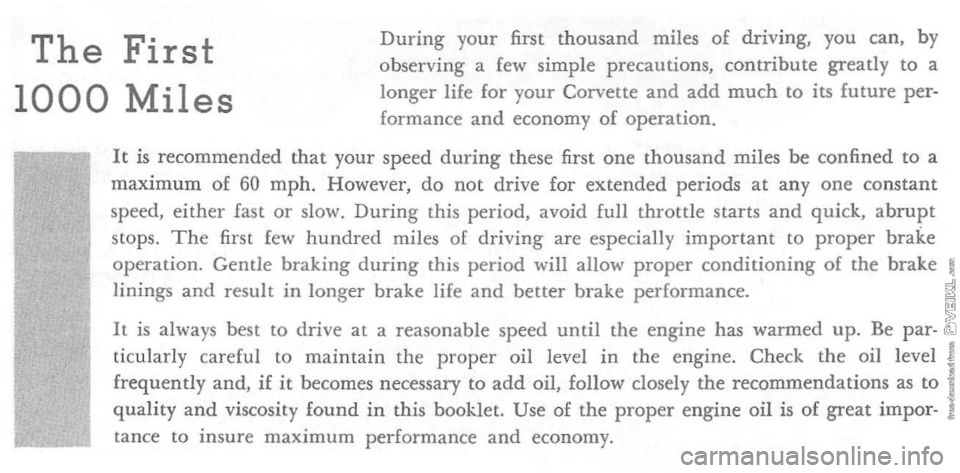
The First
1000 Miles
During your first thousand miles of driving, you can, by
observing a few simple precautions. contribute greatly to a
longer life for your Corvette
and add much to its future per
formance and economy of operation.
It
is recommended that your speed during these first one thousand miles be confined to a maximum of 60 mph. However, do not drive for extended periods at anyone constant
speed, either fast or slow. During this period, avoid full throttle starts and quick, abrupt stops. The first few hundred miles of driving are especially important to proper brake
operation. Gentle braking during this period will allow proper conditioning of the brake
linings and result in longer brake life and better brake performance.
It
is always best to drive at a reasonable speed until the engine has warmed up. Be particularly careful to maintain the proper oil level in the engine. Check the oil level
fre quently and, if it becomes necessary to add oil, follow closely the recommendations as to
quality and viscosity found in this booklet. Use of the proper engine oil is of great impor
tance to insure maximum performance and economy.
Page 28 of 52
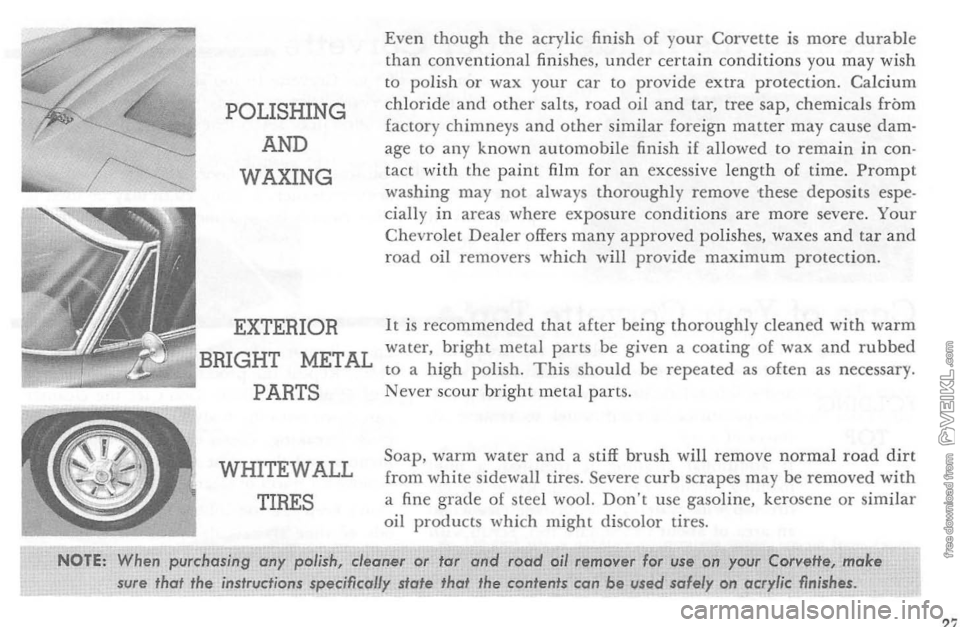
POLISHING AND
WAXING
METAL
WHITEWALL
TIRES
Even though the acry lic finish of your Co rvette is more durable than conventional fini shes. under certain conditions yo u may wish to polish or wax your car to provide extra protection. Calcium chloride and other salts, road oi l and tar, tree sap . chemica ls from fac tory chimneys and oth e r s imilar foreign matter may cause damage to any known automobile finish if allowed to remain in con
t act with the paint film for an excess ive length of time. Prompt washing may not always t horoughly r emove these deposits especially in areas where exposure conditio n s are more severe. Your Chevrolet Dealer offers many approved polishes . waxes and ta r and road oil removers which will provide maximum protection.
It is recommended that afte r being thoroughly cle a n ed with wa r m
water, bright metal parts be g iven a coating of wax and rubbed to a high polish. This should be repeated as often as necessary. Never scour bright meta l parts.
Soap,
warm water and a s tiff brush will remove normal road dirt
from white sidewall tires. Severe curb scrapes may b e removed with a fine grade of stee l wool. Don't use gasoline, kerosene or similar oil products w h ich might d i scolo r tires.
NOTE: When purchasing ony polish, cleaner or tar and road oil remover for use on your CorveHs; make
sure thot the instructions specifically state that the contents can be used solely on acrylic finishes.
27
Page 31 of 52
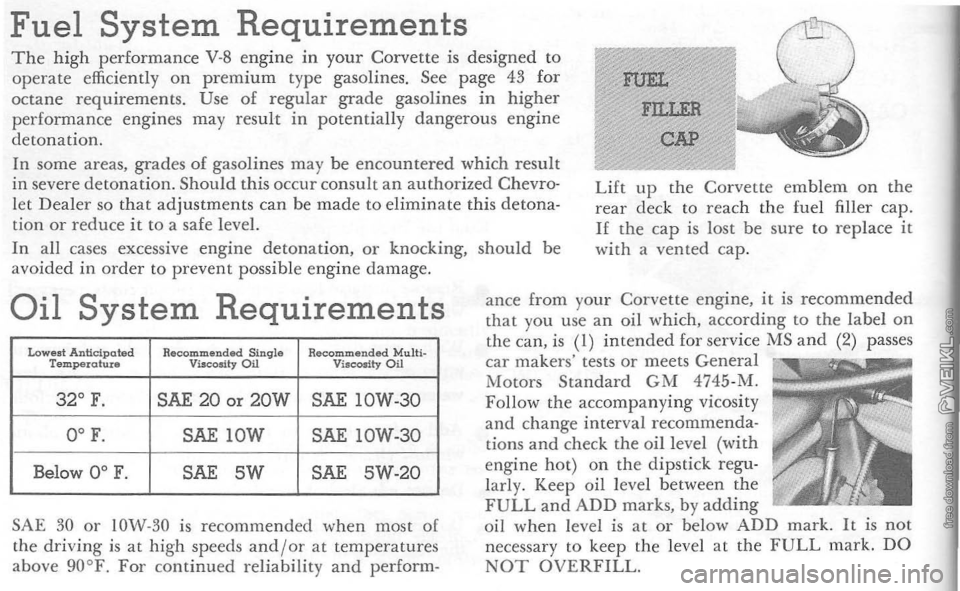
Fuel System Requirements The high performance V-8 engine in your Corvette is designed to operate efficiently on premium type gasolines. See page 43 for
octane requirements. Use of regular grade gasolines in higher
performance engines may result in potentially dangerous engine
detonation.
FUEL
FILLER
CAP In some areas, grades of gasolines may be encountered which result
in severe detonation. Should this occur consult an authorized Chevro
let
Dealer so that adjustments can be made to eliminate this detona
tion or reduce it to a safe level.
Lift tip the Corvette emblem on the rear deck to reach the fuel filler cap. II the cap is lost be sure to replace it with a vented cap.
In
all cases excessive engine detonation, or knocking, should be
avoided in order to prevent possible eng ine damage .
Oil System Requirements
Lowest Anticipated Recommended Singhl Recommended Multi-Tempefohue Viscosity Oil ViltIcosltyOil
32 0
F. SAE 20 or 20W SAE 10W-30
0 0
F. SAE lOW SAE IOW-30
Below 00
F. SAE 5W SAE 5W-20
SAE
30 or IOW-30 is recommended when most o[
the driving is at high speeds and/or at temperatures
above gO°F . For continued reliability and perform- ance
from your Corvette
engine, it
is recommended
that you use an oil whic h, according to the label on the can, is (I) intended for service MS and (2) passes car makers' tests or meets General
Motors Standard GM 4745 -M.
Follow the accompanying vicosity
and change interval recommenda
tions
and check the oil leve l (with
engine hot) on the dipstick regu
larly. Keep oil level between the
FULL and ADD marks, by adding oil when level is at or below ADD mark. It is not
necessary to keep the level at the FULL mark. DO NOT OVERFILL.
Page 33 of 52
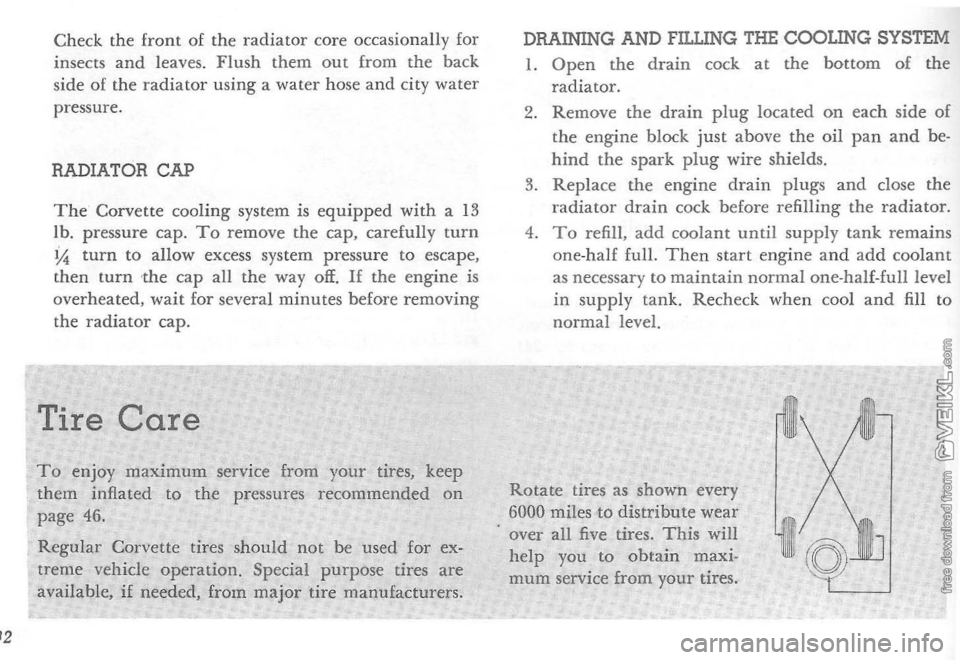
Check the front of the radiator core occasionally for
insects and leaves. Flush them out from the back
sid e of the radiator using a water hose and city water
pressure.
RADIATOR CAP
The Corvette cooling system is equipped with a 13 lb. pressure cap. To remove the cap, carefully turn ~ turn to allow exces s system pressure to escape, then turn the cap all the way off. If the engine is
ov erh eated, wait for several minutes before removing
the
radiator cap.
Tire
Care
To enjoy maximum service from your tires, keep
them inflated to the pressures recommended on
page
46.
Regular Corvette tires should not be used for ex
treme vehicle operation. Special purpose tires are
available,
if needed, from major tire manufacturers. DRAINING
AND FILLING
THE COOLING SYSTEM
I. Open the drain cock at the bottom of the
radiator.
2. Remove the drain plug located on each side of the engine block just above the oil pan and be· hind the spark plug wire shields. 3. Replace the engine drain plugs and close the
radiator drain cock before refilling the radiator.
4.
To refill , add coolant until supply tank remains
one -half full. Then start engine and add coolant as necessary to maintain normal one-half- full level in supply tank. Recheck when cool and fill to
normal level.
Rotate tires
as shown every
6000 miles to distribute wear
. over all five tires. This will help you to obtain maxi
mum service from your tires.
Page 36 of 52
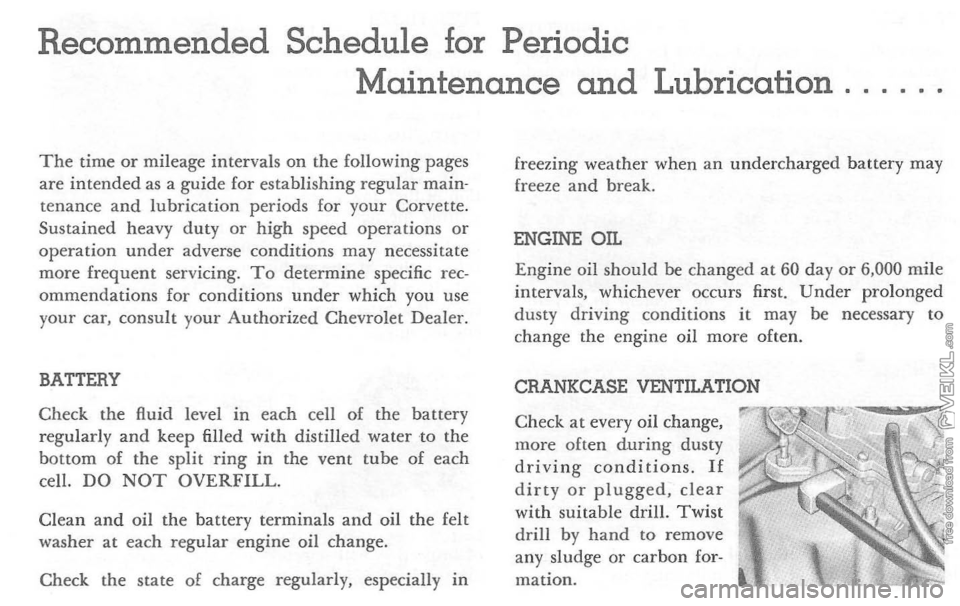
Recommended Schedule for Periodic
Maintenance
and Lubrication
The time or mileage intervals on the following pages
are intended as a guide for establishing regular main
tenance and lubrication periods for your Corvette .
Sustained heavy
duty or high speed operations or operation under adverse conditions may necessitate
more frequent servicing. To determine specific recommendations for conditions under which you use
your car, consult your Authorized Chevrolet Dealer.
BATTERY
Check the fluid level in each cell of the battery regularly and keep filled with distilled water to the bottom of the split ring in the vent tube of each
cell. DO NOT OVERFILL.
Clean and oil the battery terminals and oil the felt
washer at each regular engine oil change.
Check the state
of charge regularly, especially in
freezing weather when an undercharged battery may
freeze and break.
ENGINE OIL
Engine oil should be changed at 60
day or 6,000 mile intervals. whichever occurs first. U ndef prolonged
dusty driving conditions it may be necessary to
change the engine oil more often.
CRANKCASE VENTILATION
Check
at every oil change,
more often during dusty driving conditions. If dirty or plugged, clear with suitable drill. Twist drill by hand to remove
any sludge or carbon for
mation.
Page 43 of 52
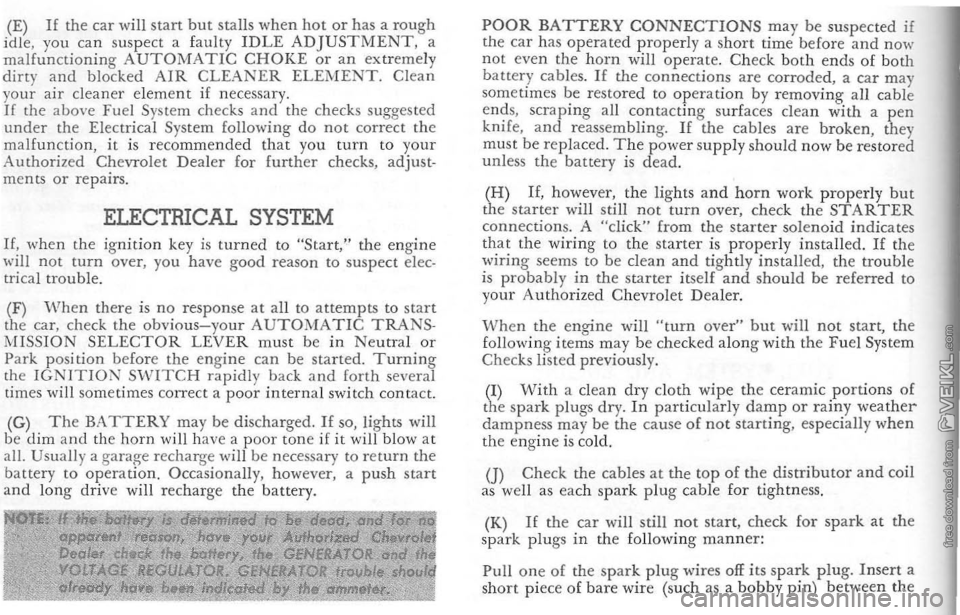
(E) If the car will start but sta lls w h e n hot or has a roug h idle, you can sus pect a f aulty IDLE ADJUSTMENT, a malfunctioning AUTOMATIC CHOKE or an extremely
dirty and blocked AIR CLEANER ELEMENT. Clean
your air cleaner element if necessary. If the above Fuel Syste m checks and the checks suggested under the Electr ica l System followi ng do not corre ct the malfunction , i t is recommended that you turTI to your Authorized Chevrolet Dealer for further checks, adjust
ments or repairs.
ELECTRICAL SYSTEM If, when the ignition key is turned to "Star t," the engine
will not turn over, you have good reason to sus pec t elec
trical trouble.
(F) '
Vhen there is
no response at all to attempts to star t
the car , check the obv ious-your AUTOMATIC TRANS· M ISSION SELECTOR LEVER mus t be in Neutral or Park position befor e the engine can be started. Turning
the IGNITION SvVITCH rapidly back and forth several
times will sometimes correct a poor internal switch contact.
(G) The BATTER Y may be discha rged. If so, lights will
be dim and the horn will have a poor tone if it will blow a t
all. Usually a
garage recharge will be nece ssary to return the battery to operation. Occasiona lly, however, a p u sh start and long driv e will recharge the battery .
POOR BATTERY CONNECTIONS may be suspec ted if
th e car has operated prope rly a short time befor e and now not eve n the horn will operate. Check both ends o f both battery cables. If the connections are corroded, a car ma y
som etimes be restore d to operation by removing all cab le
e n ds, scraping all contacting surfaces clean with a pen
knife, and reassembling. If the cables a r e broken, they
must be replaced. The power supply should now b e restored
unless the battery is dead.
(H)
If, however, the lights and horn work properly but
th e starter will still not turn ove r , c heck the STARTER connections. A "click " from the starter soleno id indicates
th a t the wirin g to the starter is properly install ed. If the
wiring seems to be clean and tightly installed, the trouble
is proba bly in the starter itself and sho uld be referred to
your Authorized Chevr olet Dealer.
When the e ngine will "turn ove r " but will not start, [h e
foll owin g items may b e checked along with the Fuel Syst em
Checks listed previous ly.
(I) With a clean dry cloth wipe the ceramic portions o f
t he spark plugs dry. In particul arly damp or rainy weather dampness may be the cause of not starting, espec ially when the e ngin e is cold.
0) C heck the cables
at the top of the distributor and coil as well as eac h spark plug cable for tightness.
(K)
If the car w ill stilI not st art. ch eck for spark at the
spark plugs in th e foll owing manner:
Pull o n e of the spark plug wi res off its spark plug. Insert a
short piece of bare wir e (such as a bobby pin) between the